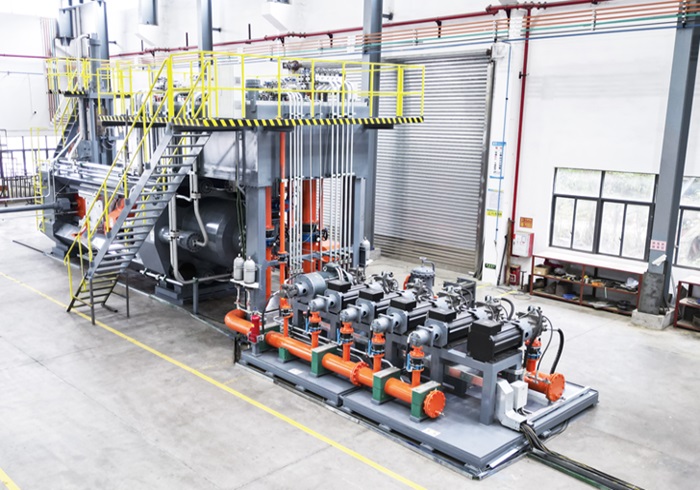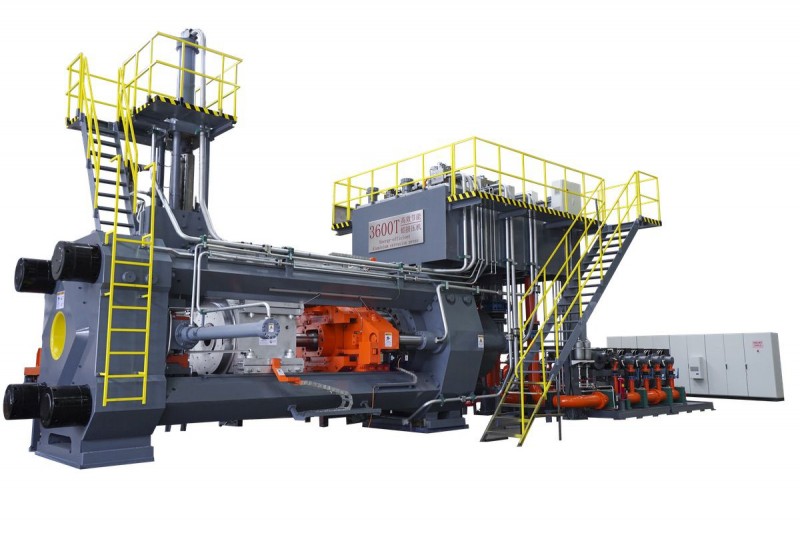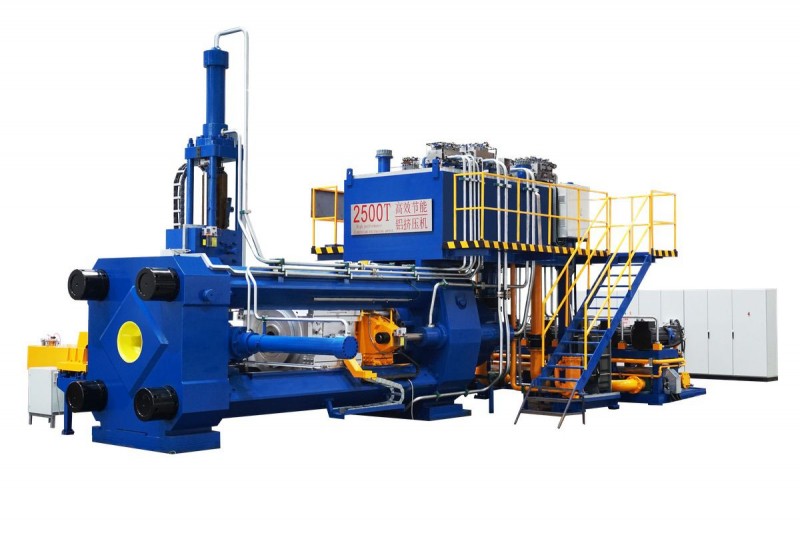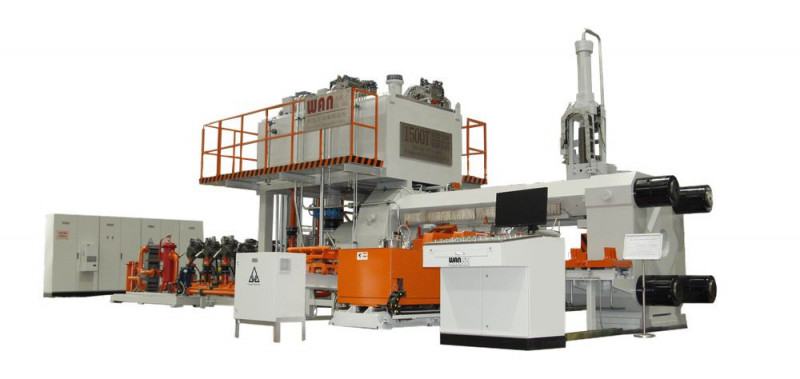Aluminum extrusion is a common method used in various industries to shape aluminum into complex profiles and structures. During this process, oil acts as a lubricant that helps aluminum move easily and ensures that the extruder's quality, precision, and life are maintained.
Oil is not just about allowing parts to move freely within the extrusion machine; it contributes significantly to the end product's quality, precision, and the extruder's overall lifespan. It acts as a guardian, ensuring the extruder operates for extended hours, reaching its full estimated lifespan. In essence, oil is the unsung hero behind the scenes, quietly enhancing both the efficiency and durability of the aluminum extrusion process.

Removing oil from an extruder goes beyond maintenance; it involves an effort to uphold the integrity of the products. Employing techniques and adhering to practices are crucial, in this process as they ensure the elimination of residues without compromising the functionality of the extruder. By following these practices manufacturers can ensure operation of their extrusion machinery providing them with peace of mind and confidence in their production processes.
The presence of oil in extrusion serves purposes, including lubrication for components. However, it is important to note that oil residues can negatively impact the surface quality of aluminum leading to blemishes, stripes or a dull appearance. Industries that prioritize aesthetics such as architecture or consumer electronics place importance on maintaining quality final products. Therefore, careful selection and maintenance of oil are paramount.
In addition, residual oil can also affect the accuracy of aluminum. It may result in melting and flow patterns leading to variations in dimensions and tolerances. For industries that heavily rely on precision, like aerospace sectors where uniformity's crucial, understanding how oil influences dimensional accuracy is essential.
Lastly it is important not to overlook the risk of corrosion associated with oil presence.
Several types of oils have the potential to compromise this characteristic whereas aluminum is recognized for its resistance, to corrosion. Excessive buildup of oils can foster an environment thereby posing a threat, to the durability and functionality of various tools extrusion dies and extruded profiles. It, therefore, becomes crucial to identify and manage such risks, especially in applications where the longevity of aluminum products must be ensured.
Aluminum extrusion plays a role, in industries. It involves shaping aluminum into profiles and structures. However, behind the scenes there is effort put into cleaning oil from the aluminum extruders. This step is essential for preventing defects and ensuring high quality aluminum profiles.
When oil is present during the extrusion process it can create air spaces and bubbles that negatively impact the properties of the products. Additionally, if there are oil marks on the surface it can lead to surface defects and blemishes that affect the appearance and marketability of the end product.
By implementing a program to remove oil from aluminum extruders we not prevent defects but also uphold quality standards and achieve customer satisfaction. Unsoiled profiles not look visually appealing without any leftover oil marks. Also contribute to an overall perception of higher product quality.
Furthermore, precise dimensions and tolerances are crucial for profiles to fit perfectly and function as intended. Residual oil residues can compromise this precision leading to variations that impact performance.
In summary eliminating oils from aluminum extruders is vital for defect prevention maintaining high quality standards meeting customer expectations in terms of appearance and ensuring dimensions, for functionality.
If the process of cleaning the oil is not efficient it can negatively impact the accuracy of the end products, which in turn compromises their quality standards.
Oil contamination brings a real risk of corrosion, especially in corrosive environments. Additionally, oil residues pose challenges to extrusion dies and tooling, increasing maintenance costs and possibly causing production delays.
Risk of Corrosion: A comprehensive plan for oil cleaning considerably reduces corrosion risk on extruded profiles, which is essential, especially in applications faced with difficult environmental conditions. Over time, maintaining material characteristics becomes very important. Hence, the significance of oil cleanliness.
Tooling Protection: Oil residues may accumulate on other parts, such as extrusion dies and tooling, resulting in damage that could greatly affect production. By so doing, the systematic removal of oil ensures smoother operations during production, minimizing unforeseen downtime.
1. Increases Efficiency of Heat Transfer: Oil residues may decrease heat transfer efficiency by being an insulator. When using the extruder, it takes a cleaned surface to achieve increased efficiency.
2. Preventing Oxidation: With ultra-high temperatures, oil oxidizes and forms varnish and sludge. The formed products will affect the quality of the extruded profile and, at the same time, will block filters and clog hydraulic systems. Proper cleaning, therefore, would minimize the risk of oxidation that may destroy the extruder or finalize the product's quality.
3. Increased Lifespan of Consumable Parts: Consumable parts like seals and gaskets may undergo accelerated wear and tear performance due to oil residues. When proper cleaning is carried out at intervals, these consumable parts last long, reducing replacement frequency attached costs.
4. Adherence to Environmental Rules and Regulations: In most cases, the environmental rules and regulations that describe industrial operations tend to be very strict. Proper oil cleaning guarantees compliance, hence preventing oil drainage and contamination which is considered among the commitment towards environmental care.
5. Optimized Extrusion Speeds: Material flow in smoothness through clean extruders facilitates optimized extrusion speeds. It directly impacts production efficiency and runs over demanding schedules or delivery timelines.
6. Minimization of Residual Contaminants: Other than the oil, other contaminants in manufacturing may include dirt, debris, or metal fines. Routine cleaning will ensure minimizing these contaminants, hence no risk of creating a problem as the extrusion process continues.
7. Facilitation of Troubleshooting and Maintenance: A clean extruder does away with troubleshooting and maintenance towards a clear background. Issues identification encompassing leaks, wear patterns, or malfunctions become more accessible, facilitating the remedy to probable problems.
The importance of oil cleaning is evident. It’s crucial to consider the methods and techniques used in this process. Let’s take a look, at the tools for effective oil cleaning.
One approach involves removing oil residues from the surface of the extruder. This can be done through brushing scraping or utilizing high pressure water or steam cleaning. To enhance cleaning, equipment like oil skimmers or vacuum systems can be utilized.
Chemical cleaning agents play a role in dissolving and eliminating oil residues. Solvent based cleaners are effective in breaking down oil. Can be applied using brushes or sprayers. Alkaline cleaners are specifically designed for applications as they effectively remove oils and greases. For those who prefer options citric acid-based cleaners provide a less harsh alternative to solvent based ones.
Integrating automation enhances the efficiency and effectiveness of oil cleaning, on aluminum extruders. Robotic cleaning systems programmed for cleaning ensures results. Advanced ultrasonic cleaning technology has been developed to remove oil residue by utilizing frequency sound waves. Enclosed cleaning chambers create a controlled environment that facilitates removal of oil while minimizing environmental impacts.
To keep the aluminum extruders clean it's important to be proactive, with maintenance. This involves checking for any oil buildup or contamination and scheduling routine cleaning cycles. Taking preventative steps by engaging in routine maintenance enables one to address potential problems before they deteriorate into major issues, thus protecting the extruder's health and the end product's quality.
The necessity of using best practices must be recognized because this will lead to comprehensive and enduring oil-cleaning aluminum extruder techniques.
Creating a program for cleaning on a regular basis is vital in averting unnecessary oil build-up. Number of extrusions runs, type of oil used, and level of contamination are some factors to consider in scheduling. As such, the cleaning schedule ensures that product quality remains constant while preventing long-term accumulation of oils.
People aspect is very important as far as effective cleanliness of oil is concerned. For this reason, it would be better if the cleaners were well trained by teaching them about oil cleaning process, what it involves and how it can be done with the various methods available. To ensure a properly maintained extruder free from any oils one should clean consistently.
Therefore, clarity is important on matters regarding cleaning. Thus, clear procedures and protocols for cleaning must be established so that this function may run smoothly. Thus, it may specify how to clean it up or which chemicals to use or even what equipment should be employed. Therefore, standard operating procedures enhance consistent and proper removal of oils from aluminum extruders
Synthetic oils, regarded as crucial products used for extruder lubrication, are crafted painstakingly inside state-of-the-art laboratories. These are not mere products but results of painstaking dedication to precision in manufacturing circles. Designed specifically to match rigorous performance requirements, synthetic lubricants are a tribute to scientific evolution.
They can resist high temperatures, meaning they remain useful in extrusion. This oil is also resistant to oxidation, maintaining its integrity and optimal functionality for long periods. It lubricates well, improving the efficiency of this machine.
Now, mineral oils are cheaper options for some specific extruders than synthetic oils. The petroleum-based products are refined to meet some specifications. Instead of their artificial alternatives, these mineral products might have different thermal stability or oxidizing resistance levels, but they work well where the extrusion process is less demanding.
The choice between synthetic and mineral oils cannot be specified because it depends on what each machine needs and how it operates. Manufacturers consider these things when making recommendations because they understand that every oil has strengths and weaknesses.
Because they get very hot during the process and have to do a lot of hard work, it is differentiating demands that extrusion machines are subjected to. As a response, manufacturers’ give recommendations on lubricating oils which are fragile based on rigorous research methods, exactness of engineering skills as well as deep knowledge about intricacies associated with the working of extrusion.
These guidelines are not arbitrary or inflexible; they come from the commitment to improving performance and longevity. The result for violating these guidelines usually begins with escalated frictional wear, instability of parts and eventual failure of some critical function upon which the life of an extruder depends disastrously.
Apart from technical demands, other things are considered by manufacturers when selecting particular oils. Also, this further helps in reducing ambiguity by telling drivers what to use for their vehicles, considering environmental factors and safety as well. This is how the manufacturers always approach things. For example, another choice could have been fitting fire retardant hydraulic fluids on those extruders situated within hazardous places.
Given that such mistakes can be repeated throughout the life span of an extruder, these repercussions resulting from using any different oil may turn out to be disastrous for a manufacturing company. Overheating incompatibility with wrong oils could lead to excessive part wear and even product quality reduction. Furthermore, warranties may be voided by some wrong choices concerning oils. Consequently, businesses shall incur unexpected costly repair services.
This implies utmost care at all times during handling this machine since it means that every small part has its functional role which determines proper operation while greased by the designated lubricant. Any deviation from these set guidelines can disrupt this balance, leading to consequences beyond the initial act of experimentation.
It is essential to clean oil from aluminum extruders to ensure top-notch aluminum profiles, keep customers satisfied, minimize corrosion risks, and preserve production equipment. You can ensure optimal performance by comprehending the impact of oil on extrusion, employing cleaning methods and techniques, following practices, and regularly maintaining your extruders.


